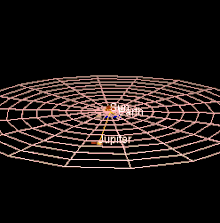 Fifty new alien worlds, including 16 "super Earths," have been found—the largest extrasolar planet haul announced at one time, astronomers say. The discoveries bring the total number of known extrasolar planets, or exoplanets, to 645.
Fifty new alien worlds, including 16 "super Earths," have been found—the largest extrasolar planet haul announced at one time, astronomers say. The discoveries bring the total number of known extrasolar planets, or exoplanets, to 645.
"The harvest of discoveries ... has exceeded all expectations, and includes an exceptionally rich population of super-Earths and Neptune-type planets hosted by stars very similar to our sun," study leader Michel Mayor, an astronomer at the University of Geneva in Switzerland, said in a statement.
Fifty New Planets Found—Largest Haul Yet
New Fossils May Redraw Human Family Tree
 An apelike creature with human features, whose fossil bones were discovered recently in a South African cave, is the most plausible known ancestor of archaic and modern humans, the scientists who discovered the fossils say.
An apelike creature with human features, whose fossil bones were discovered recently in a South African cave, is the most plausible known ancestor of archaic and modern humans, the scientists who discovered the fossils say.
The claim, if accepted, would radically redraw the present version of the human family tree, placing the new fossil species in the center. The new species, called Australopithecus sediba, would dislodge Homo habilis, the famous tool-making fossil found by Louis and Mary Leakey, as the immediate human ancestor.
NASA launches Web tool to explore the solar system
 Want to explore the solar system and follow NASA space missions in real time?
Want to explore the solar system and follow NASA space missions in real time?
The National Aeronautics and Space Administration is giving the public the chance to do just that through a new Internet-based tool called Eyes on the Solar System. The space agency said the tool combines video-game technology and NASA data to create an environment for users to ride along with agency spacecraft as they explore the cosmos.
Scientists Create World's First Molecule-Sized Electric Motor
 Researchers at Tufts University in Massachusetts have created the world's smallest electric motor, the size of a single molecule, recently publishing the results in the scientific journal Nature Nanotechnology. Although applications for the nanoscale device are a long way off, the achievement could one day lead to nanoscale machines capable of performing surgery on a single cell, for instance.
Researchers at Tufts University in Massachusetts have created the world's smallest electric motor, the size of a single molecule, recently publishing the results in the scientific journal Nature Nanotechnology. Although applications for the nanoscale device are a long way off, the achievement could one day lead to nanoscale machines capable of performing surgery on a single cell, for instance.
The motor is made of a single molecule of butyl methyl sulfide—basically a sulfur molecule with two "arms" made of carbon and hydrogen atoms (the yellow-and-green dots in the middle of the photo to the left).
Astronomers discover planet made of diamond
Astronomers have spotted an exotic planet that seems to be made of diamond racing around a tiny star in our galactic backyard.
The new planet is far denser than any other known so far and consists largely of carbon. Because it is so dense, scientists calculate the carbon must be crystalline, so a large part of this strange world will effectively be diamond.
Life on Mars? Fossil find shows it's possible
 Scientists have found Earth's oldest fossils in Australia and say their microscopic discovery is convincing evidence that cells and bacteria were able to thrive in an oxygen-free world more than 3.4 billion years ago.
Scientists have found Earth's oldest fossils in Australia and say their microscopic discovery is convincing evidence that cells and bacteria were able to thrive in an oxygen-free world more than 3.4 billion years ago.
The finding suggests early life was sulphur-based -- living off and metabolizing sulphur rather than oxygen for energy -- and supports the idea that similar life forms could exist on other planets where oxygen levels are low or non-existent.
NASA reports breakthrough in space weather monitoring
 Thanks to data collected from NASA's Solar Terrestrial Relations Observatory (STEREO) and advances in modeling, scientists can for the first time watch a coronal mass ejection from its formation on the sun to its impact with the Earth's magnetosphere.
Thanks to data collected from NASA's Solar Terrestrial Relations Observatory (STEREO) and advances in modeling, scientists can for the first time watch a coronal mass ejection from its formation on the sun to its impact with the Earth's magnetosphere.
The most powerful CMEs, enormous magnetized clouds of electrified gas emitted from the sun, that hit the Earth's protective magnetic field can disrupt satellites, radio signals and even the electric grid.
More Articles...
Page 38 of 61

 Science Glance
Science Glance






























